A driveway is a passageway for motor vehicles that enables them to access private property adjacent to the road.
Where they cross footpaths, driveways behave in many respects like intersections, as vehicles can cross pedestrian routes and effectively sever the walking network. Drivers are required to give way to pedestrians on the footpath at driveways, unlike at most intersections where drivers have priority. If traffic volumes using the driveway are very low, pedestrians can use the driveway to access the adjacent property or footpath.
Vehicles crossing footpaths conflict with people using the footpath and are hazardous where visibility is restricted, or vehicles are reversing. Also driveways are a common cause of adverse crossfalls on the footpath. Young children (under four years old) are particularly at risk of serious injury and even death on driveways, especially at their own home. In many cases, the driver of the vehicle involved is a parent or relative who is reversing.
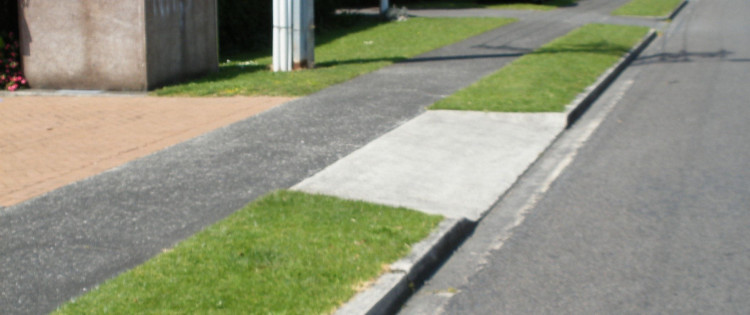
Path surface material continues across the driveway.
The Land Transport Rule 2004 defines a driveway as ‘a place used or appearing to be used as a vehicle entrance to or exit from land fronting a roadway’. A driver entering or exiting must give way to a road user on a footpath, cycle path, or shared path, and then to vehicles on the roadway.
The following principles apply when locating both residential and commercial driveways:
When designing driveways, the following principles apply:
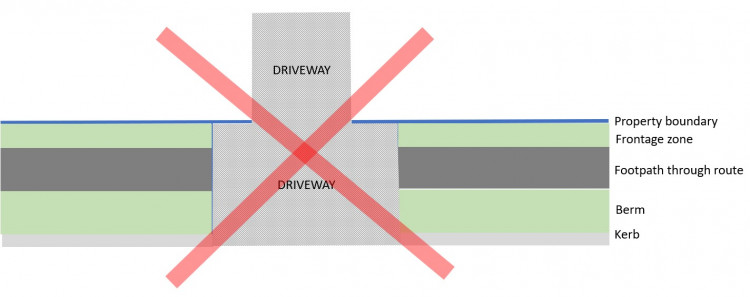
Unacceptable: driveway is wider at the footpath than it is at the property boundary.

Driveway with normal pedestrian path crossfall maintained, Queenstown. (Photo: Tim Hughes)
Property accesses may have a higher motor traffic intensity than typical in residential areas. In these cases, designers often incorrectly mix the design elements of driveways and intersections. It is important that the priority is obvious for all road users.
Table: Differences between driveway and intersection styles of property access
|
Element |
Driveway |
Intersection |
|
Basic principle |
Most property accesses should be designed as a driveway, reflecting the law that drivers are required to give way to all other users when entering or leaving the roadway. |
A property access should only be designed as an intersection if:
|
|
Footpath design |
Continuous in grade, crossfall, colour and texture[3] |
Generally not continuous, except when pedestrian priority is assigned with other means |
|
Tactile warning |
No |
Yes |
|
Pedestrian priority |
Yes |
Generally no, unless other measures are installed to provide pedestrian priority (eg zebra crossing or two parallel white lines (subject to Accessible Streets package) |
|
Kerb alignment |
Continuous along roadway, with a cut-down that drops to a concrete gutter crossing Kerb does not return into the driveway |
Kerb returns into the side street |
|
Kerb cutdown to road |
Yes |
No |
|
Illustration |

Footpath continuous surface at driveway. |
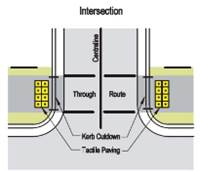
Intersection layout where footpath is not continuous. |
The following table illustrates good and poor practice for the design of high-volume three-lane property accesses in central Christchurch, on the same street.
Comparison of driveway and intersection design for high volume access in central city context
|
Good practice |
Poor practice |
|
This example shows a car parking building with three-lane access built as a driveway. This illustrates good design features that reinforce pedestrian priority:
The tactiles are confusing in terms of priority and a better approach would be to put the onus on drivers to watch out for pedestrians (eg vertical deflection). |
This examples shows a high-volume car parking building with three-lane access built as an intersection. This illustrates two main shortcomings:
|
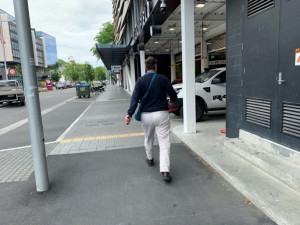
High-volume accessway built as a driveway. |

High-volume accessway built as an intersection. |

A corner visibility splay improves visibility. |
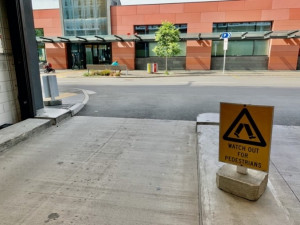
A right-angle solid wall limits intervisibility. |
At any high volume access exit, provision of signs and vertical deflection (eg speed hump) may be considered to provide additional cues to drivers that they must give way.
Driveways should have a level landing at the top (similar to a kerb ramp), and the through width should be as per the Minimum Footpath Widths table.
Where a path crosses a property access driveway, the path should have a continuous grade across the driveway and preferably the same crossfall as the adjoining path segments.[4]
The crossfall should be as flat as practicable consistent with achieving adequate drainage, and no greater than 1:50 (2%). To achieve this, the sloped part of the driveway should be within the street furniture zone and/ or the adjacent private property[5]. It may be necessary to lower the footpath (see Parallel graphic below).
There are three interface scenarios as shown below, perpendicular, combination and parallel.
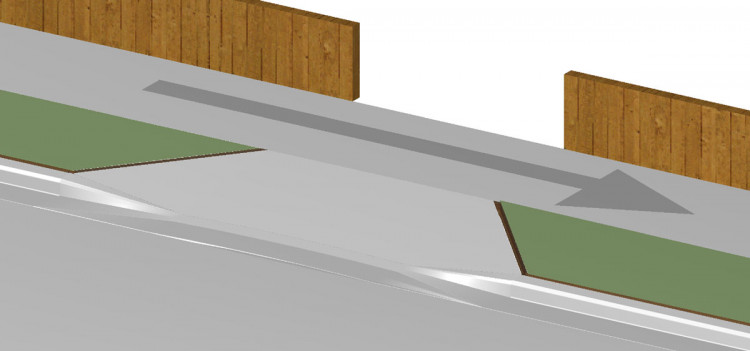
Perpendicular.

Combination.
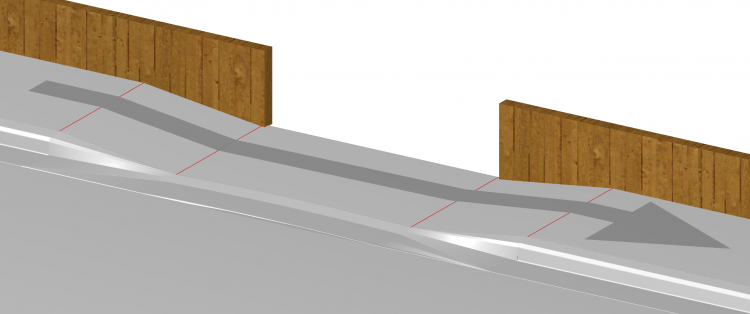
Parallel (to be used only in existing circumstances).
In some situations, there is insufficient space to form perpendicular or combination ramps and there are practical or aesthetic reasons not to do a series of parallel driveways.
Where it is desired to maintain a level footpath immediately behind (or near) the kerb, there are three options:
This is not easily mountable for people using most wheeled devices or bicycles.

Example of a chamfered kerb in Rolleston. (Photo: Jeanette Ward)
This provides a mountable option but may be insufficient to discourage motorists from encroachment of the footpath (compared to a vertical kerb face).
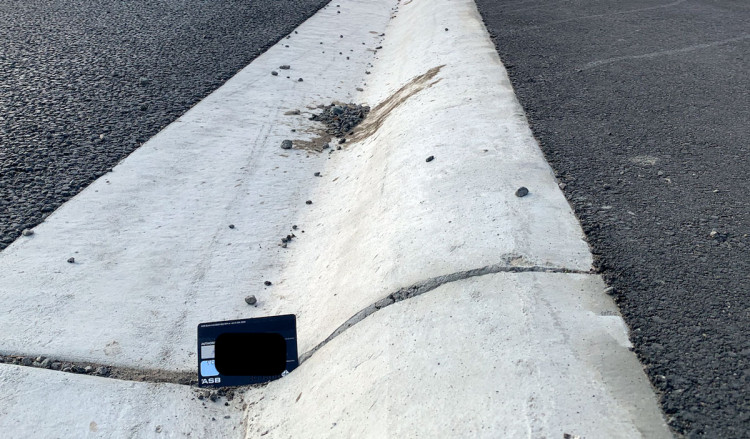
Rolled kerb profile - Christchurch. (Photo: John Lieswyn)
This is fully traversable, but it should be designed to minimise vehicular intrusion into the footpath space.
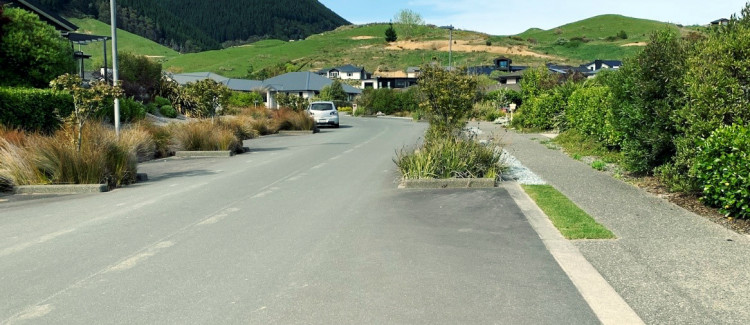
Flat 'kerbless' street maintains a flat footpath in a constrained corridor - Nelson. (Photo: John Lieswyn)
For more information on designing high vehicle use accesses:
[1] A high-volume driveway is defined as having 200 or more vehicle movements per day: LTSA (1993). Guidelines for visibility at driveways RTS 6(external link).
[2] The reason to choose 500 as a threshold is to give the benefit of priority to pedestrians in more situations than defined by the 200 value in the Guidelines for visibility of driveways (RTS6).
[3] [4] Austroads. (2017). Guide to Road Design Part 6A: Paths for walking and cycling(external link)
[5] Austroads GRD6A recommends a minimum of 0.2m from the edge of the through zone to the top of the kerb (plus the width of the kerb) to allow for the development of the kerb ramp, and a desirable minimum of 1.0m to allow for parked car door openings. This latter point is especially important to minimise the risk of injury to pedestrians on small wheels.